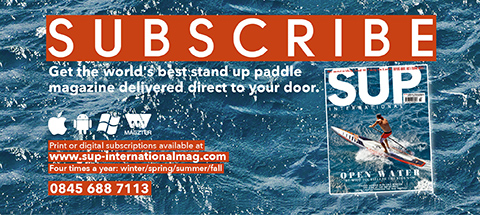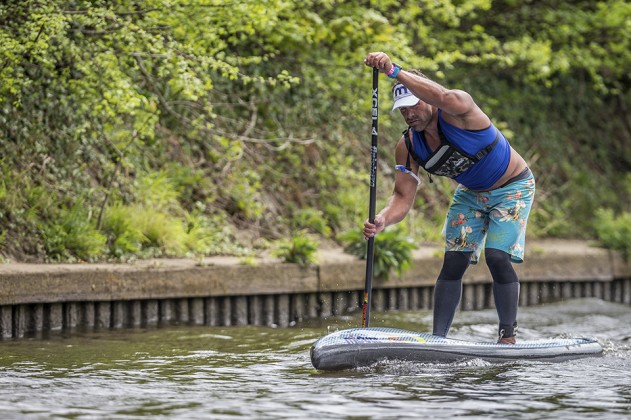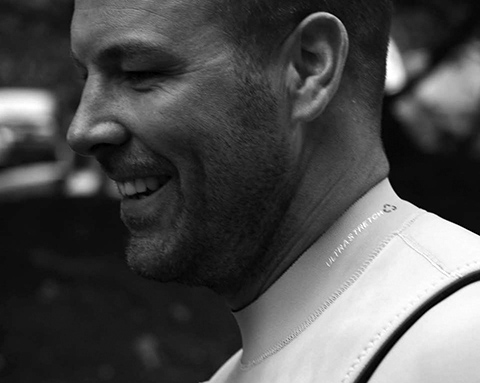RYAN JAMES KNOWLEDGE – STRUCTURE = FREEDOM
Training. The very thought of it has encouraged many people to take up a paddle as a way to improve their lives so they can avoid the drudgery and pain associated with the word. But as Ryan James explains, paddling with a plan can enrich your entire experience on the water from the surf through to racing, to just splashing about with your kids. The right approach can make you stronger, faster, more efficient, and most importantly, inspired to paddle for many years to come. Here’s an introduction to how a little structure can give you a lot more freedom…
With Ryan James // Photos Dave White
What did you think of the St. Ives event, a positive step for UK paddling?
Chris Parker (SUP Racer) and Bellar Diaz (SIC) euro tour event in St Ives put on by Glenn Eldridge was awesome and a great step for the UK, I hope next year it will be absorbed into the main UK SUP race series as We need more support from UK paddlers, a lot were missing and a lot of high level international competitors were there. They missed a great opportunity to to hang out with paddle celebs and ask the questions you never get to ask.
A word that keeps cropping up in conversations on sup training is periodisation. What is periodisation and is it a practical concept for most paddlers to adopt?
For the correct training plan, periodisation is essential; if you want to do well at any event then you have to consider this. Yes, at a basic level it is easy for most people to grasp the basics. Periodisation just means the separation of your training calendar into segments; this is usually done in half year to year long blocks which we call the Macrocycle. The smaller segments like sessions, weekly plans and monthly blocks form the Microcycle aspects.
Other than potentially making a paddler faster on the water, are there other benefits we can expect with a periodised training plan?
Periodising your training helps prevent overtraining, illness and injury, and the older you are the more investment in recovery there has to be made. Recovery doesn’t just mean an absence of training; it means a mental focus on repair and recovery of all the systems, especially muscular and neurological. It also means that the whole process is goal driven and that every phase, block and session has a purpose. Many athletes be they recreational, weekend warriors and even elite level usually confuse the aspects of training thinking ‘more is better’. This is wrong in most cases, quality beats quantity every time. If you want to do well, engage someone who knows what they’re doing. I have at least three of four people that advise me and I have teaching people how to train and training myself for over 20 years. Don’t let your ego, or the fact you read a book get in the way of consulting people that are in the know.
What’s a good basic template for people to follow?
A basic template to follow is the volume and intensity rule. Volume is the amount of work you do – km, miles, hours etc… Intensity is judged by the amount of load you lift, or how you feel on a ‘rate of perceived exertion’ scale (RPE), how high your heart rate is (HR) and so on. The rule is that if volume goes up intensity has to come down, if intensity goes up volume comes down. For example, you couldn’t run a marathon and 100m pace; you have to use different ways of producing energy (energy systems) and the higher the intensity the more recovery is needed. You can aim for a high level of fitness all year round, but it’s good to have certain events that are more important to focus on like GB team selection, or for me this year it’s the 11 Cities.
Some guides say new paddlers should start their training small and light with light workloads, giving the connective tissues and so on time to adapt, would this apply to someone who is a regular surfer or sup surfer?
Absolutely. If you look at surfing, the only aspect that is different physically is positioning yourself correctly in the line up, the paddle out and the process of catching a wave is moderate to high end aerobic and anaerobic work. Catching a wave whether you’re a long, short, body boarder or SUP surfer, it’s all anaerobic work (without oxygen), this is super high intensity and needs recovery between efforts. You only see the good, in-shape and experienced surfers taking wave after wave if the conditions are right. Beginners should always have a conditioning routine which should involve a lot of flexibility – and remember the older you are the more this becomes a focus. SUP surfers tend to make pretty good racers, you only need to look at Zane Schweitzer – he rips in the surf and makes top 5, top 10, in a lot of big events. However, they train and surf on race boards as both disciplines complement each other. I know Casper Steinfath uses the paddle back to the line up as a hard interval before each wave back in.
Almost on that note, would a crossfit style plan work for people that don’t have a lot of time, or find their plans disrupted when the surf is going off?
Variation or non-linear approaches can work for people that don’t have a lot of time on their hands or don’t want to commit to paddle training, but performance is a lot harder to predict.
If you’re beholden to the surf, take the non-linear approach and slot it in when the ocean’s flat, however you must factor in recovery. Sit down and look at what days are likely to be flat or worse than others and pick those days to get some distance in, or smash out a downwind (DW) session for distance and surfing rolled into one. Most of my big sessions are DW 2+ hours as they’re so much fun.
How big a part do you think paddling skill drills should play? And where should they go in the schedule?
Every session that you do is built around technique, as this has the biggest effect on performance. Technique needs to be exemplary in all circumstances, when you’re going slow, and when you’re going flat out. Your paddle technique should be practised in the gear (intensity) you’re paddling in for that session. If you are going to change your technique then do this in the winter or off season when there are no or minimal events that don’t really matter.
“ Being in shape – being stronger, more flexible, carrying less body fat – just makes things easier in all aspects of your life whether that’s the ability to de-stress from work, having the energy to run around after your kids or making you feel better about yourself and giving you more confidence ”
 Do you think weight training has a place in a sup racers programme? If so, what are some good movements to incorporate?
Do you think weight training has a place in a sup racers programme? If so, what are some good movements to incorporate?
Absolutely as this forms your basic conditioning process. I do two sessions a week and these are based on the 6 movements patterns available: squat, bend to extend, push (vertical and horizontal), pull (vertical and horizontal), and single leg / single arm rotation. For example, a squat movement pattern exercise would be a double kettle squat in the racked position, and pull (vertical) would be an over hand pull up. These would be done in the correct repetition ranges to complement the energy system pathway.
Is there a danger that by planning out a training regime sup becomes just another track and field event?
No, absolutely not. Being in shape – being stronger, more flexible, carrying less body fat – just makes things easier in all aspects of your life whether that’s the ability to de-stress from work, having the energy to run around after your kids or making you feel better about yourself and giving you more confidence. This transfers across to occupational and social health. There are far too many people trying to buy back their health when a good lifestyle can be achieved with minor adjustments to your current patterns.
What new trends or insights do you see developing in sup racing?
The trends will occur depending on the level that this sport develops to. If you put more money in to a sport then doping becomes more attractive to athletes. On the softer side, I can see more endurance athletes getting into the sport and hopefully more families that want to cruise and explore the harbours, inland waters and beautiful coastlines that the world has to offer. I think board development will go through the roof with a need for faster boards form every type of athlete be it the weekend warrior, elite or club participant.
What do you think is the toughest type of elite race considering both distance and conditions?
They all have their merits, but for me 11 Cities is theIron Man of SUP. There are a couple of other races popping up in the calendar that are 220km in a day in some extreme conditions, but really it’s all a matter of perspective. BOP (Battle of the Paddle in and out through surf) was heavy; having overhead sets come through when you’re heart rate’s at its limit was crazy although the carnage that usually ensued was great for the spectators. And I don’t think it’ll be long before some crazy fool attempts the Atlantic solo and unsupported. SUP



